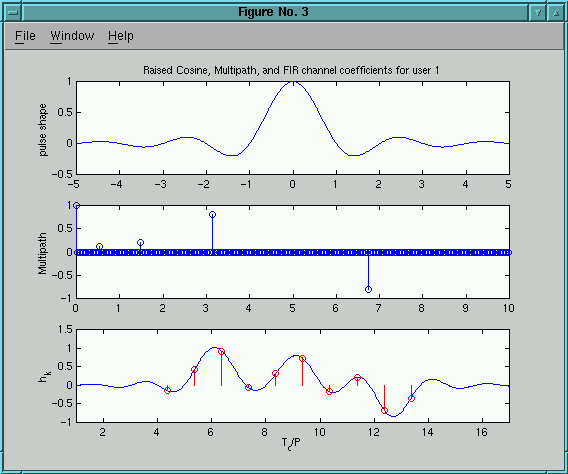



Next: Out-of-Cell Users
Up: Setting System Parameters
Previous: Spreading Codes
-
 This is the number of in-cell users. This number
can not be greater than the Spreading Gain.
This is the number of in-cell users. This number
can not be greater than the Spreading Gain.
-
 Standard Deviation of the Power
Distribution of the In-Cell users. This is only utilized if the
log normal power distribution is selected, otherwise it is ignored.
Standard Deviation of the Power
Distribution of the In-Cell users. This is only utilized if the
log normal power distribution is selected, otherwise it is ignored.

Figure 4.4: (a) Pulse shaping filter (b) multipath
rays number, delay spread, and amplitude distribution are set in
the System Parameters Window (c) Stemmed values are actual channel
coefficients
For the next four items refer to figure 4.4
-
 The number of
reflections that each of the
in cell users are afflicted by. In part (b) of the figure, we see
that the number of reflections was 5. The multipath is
convolved with the pulse shaping filter in part (a) of the figure to
get the continuous time signal shown in part (c). The signal in part
(c) is then sampled to get the
The number of
reflections that each of the
in cell users are afflicted by. In part (b) of the figure, we see
that the number of reflections was 5. The multipath is
convolved with the pulse shaping filter in part (a) of the figure to
get the continuous time signal shown in part (c). The signal in part
(c) is then sampled to get the  spaced channel coefficients.
spaced channel coefficients.
-
 This is the
delay spread of
the multipath, or the maximum delay of a reflection. In the figure,
the max chip delay of the multipath was chosen to be 7. Therefore no
reflections could occur after 7 chips.
This is the
delay spread of
the multipath, or the maximum delay of a reflection. In the figure,
the max chip delay of the multipath was chosen to be 7. Therefore no
reflections could occur after 7 chips.
-
 The multipath rays are
distributed uniformly in time, however their amplitudes have a
Gaussian distribution with zero mean and standard deviation specified
by this variable.
The multipath rays are
distributed uniformly in time, however their amplitudes have a
Gaussian distribution with zero mean and standard deviation specified
by this variable.
-
 The mean output power of the in-cell
users is set to 0 dB and can not be changed.
The mean output power of the in-cell
users is set to 0 dB and can not be changed.
Thu Dec 17 13:13:15 EST 1998
